Faisal Mosque
| Faisal Mosque | |
|---|---|
|
Shah Faisal Masjid فیصل مسجد | |
|
| |
 Location in Pakistan | |
| Basic information | |
| Location | Islamabad, Pakistan |
| Geographic coordinates | 33°43′48″N 73°02′18″E / 33.729944°N 73.038436°ECoordinates: 33°43′48″N 73°02′18″E / 33.729944°N 73.038436°E |
| Affiliation | Islam |
| Branch/tradition | Sunni Islam |
| Architectural description | |
| Architect(s) | Vedat Dalokay |
| Architectural type | Mosque |
| Architectural style | Contemporary Islamic |
| Date established | 1987 |
| Construction cost | 120 million USD |
| Specifications | |
| Capacity | 74,000 within the main areas,[1] approx. 200,000 in adjoining grounds |
| Interior area | 5,000 m2 (54,000 sq ft) |
| Minaret(s) | 4 |
| Minaret height | 90 m (300 ft) |
Faisal Mosque (Urdu: فیصل مسجد) is the national mosque of Pakistan. Located on the foothills of Margalla Hills in Islamabad, the mosque features a contemporary design consisting of eight sides of concrete shell and is inspired by a Bedouin tent.[2] The mosque is a major tourist attraction, and is referred as a contemporary and influential feature of Islamic architecture.[3][4]
Construction of the mosque began in 1976 after a $120 million grant from Saudi King Faisal, whose name the mosque bears. The unconventional design by Turkish architect Vedat Dalokay was selected after an international competition.[5] Without a typical dome, the mosque is shaped like a Bedouin tent, surrounded by four 260 feet (79 m) tall minarets. The design features eight-sided shell shaped sloping roofs forming a triangular worship hall which can hold 10,000 worshippers, while the surrounding porticoes and the courtyard up-to 200,000 more.[6]
Combined the structure cover an area of 54,000 square ft, the mosque dominates the landscape of Islamabad.[7] It is situated at the north end of Faisal Avenue, putting it at the northernmost end of the city and at the foot of Margalla Hills, the westernmost foothills of the Himalayas. It is located on an elevated area of land against a picturesque backdrop of the national park. The largest mosque in Pakistan, the Faisal Mosque was the largest mosque in the world from 1986 until 1993, when it was overtaken by mosques in MENA region. Faisal Mosque is now the fourth largest mosque in terms of capacity.[8]
History
The impetus for the mosque began in 1966 when King Faisal bin Abdul-Aziz supported the initiative of the Pakistani Government to build a national mosque in Islamabad during an official visit to Pakistan.
In 1969, an international competition was held in which architects from 17 countries submitted 43 proposals. The winning design was that of Turkish architect Vedat Dalokay.[9] Construction of the mosque began in 1976 by National Construction of Pakistan, led by Azim Khan and was funded by the government of Saudi Arabia, at a cost of over 130 million Saudi riyals (approximately 120 million USD today). King Faisal bin Abdul Aziz was instrumental in the funding, and both the mosque and the road leading to it were named after him after his assassination in 1975. The mosque was completed in 1986, and used to house the International Islamic University. Many conservative Muslims criticised the design at first for its unconventional design and lack of a traditional dome structure, but most criticism ended when the completed mosque's scale, form, and setting against the Margalla Hills became evident.
Design
The Faisal Mosque is the work of Turkish architect Vedat Dalokay, who won the Aga Khan Award for Architecture for the project. The mosque's architecture is modern and unique, lacking both the traditional domes and arches of most other mosques around the world.

The mosque's unusual design is a departure from the long history of South Asian Islamic architecture, fusing contemporary lines with the more traditional look of an Arab Bedouin's tent, with its large triangular prayer hall and four minarets. However, unlike traditional masjid design, it lacks a dome. The minarets borrow their design from Turkish tradition and are thin and pencil like.
The shape of the Faisal Mosque is an eight-sided concrete shell inspired by a desert Beduoin's tent and the cubic Kaaba in Mecca, flanked by four unusual minarets inspired by Turkish architecture. The architect later explained his thinking to design school students:[10]
| “ | I tried to capture the spirit, proportion and geometry of Kaaba in a purely abstract manner. Imagine the apex of each of the four minaret as a scaled explosion of four highest corners of Kaaba – thus an unseen Kaaba form is bounded by the minarets at the four corners in a proportion of height to base. Shah Faisal Mosque akin to Kaaba. Now, if you join the apex of each minaret to the base of the minaret diagonally opposite to it correspondingly, a four-sided pyramid shall be bound by these lines at the base side within that invisible cube. That lower level pyramid is treated as a solid body while four minarets with their apex complete the imaginary cube of Kaaba. |
” |
Entrance is from the east, where the prayer hall is fronted by a courtyard with porticoes. The International Islamic University was housed under the main courtyard, but recently relocated to a new campus. The mosque still houses a library, lecture hall, museum and cafe. The interior of the main tent-shaped hall is covered in white marble and decorated with mosaics and calligraphy by the famous Pakistani artist Sadequain, and a spectacular Turkish-style chandelier. The mosaic pattern adorns the west wall, and has the kalimah written in early Kufic script, repeated in mirror image pattern.
Nekka Phullai is the adjacent hill to the mosque in Margalla Hills.
Capacity
The Faisal Mosque has covered area of 5,000 m2 (54,000 sq ft). It can accommodate 10,000 worshipers in its main prayer hall,[1] 24,000 in its porticoes,[1] 40,000 in its courtyard,[1] and another 200,000 in its adjoining grounds. Although its covered main prayer hall is smaller than that of the Hassan II Mosque in Casablanca (the world's third largest mosque), Faisal Mosque has the third largest capacity of accommodating worshipers in its adjoining grounds after the Masjid al-Haram (Grand Mosque) of Mecca, the Al-Masjid al-Nabawi (Prophet's Mosque) in Medina. Each of the Mosque's four minarets are 80 m (260 ft) high (the tallest minarets in South Asia) and measure 10 x 10 m in circumference.
References in literature
The Faisal Mosque is described in the book The Kite Runner by Khalid Hosseini, and is frequently referenced in the work of Michael Muhammad Knight, who came to the mosque to study Islam as a teenager.
Gallery
-

Shah Faisal Masjid
-

Shah Faisal Masjid
-
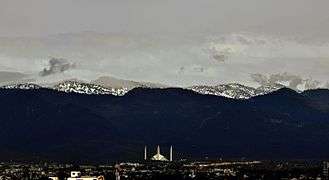
Shah Faisal Masjid
-
A view of Shah Faisal Mosque from adjoining yard.
-
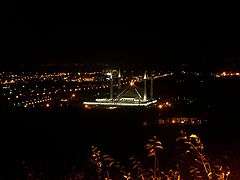
Night view of the Faisal Mosque and surrounding area
-
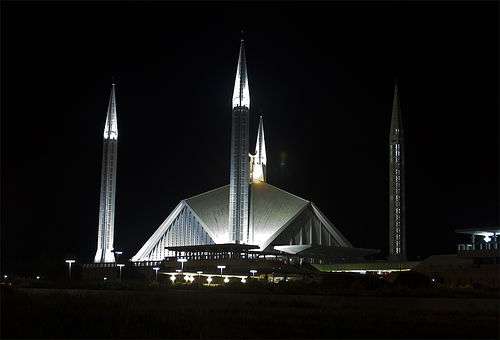
Faisal Masjid at night around prayers time
-

Faisal Masjid during 27th Ramadan(HD)
-

Faisal Masjid From Damn e Koh(HD)
-
Elevation view of the Shah Faisal Masjid
-
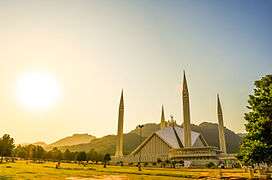
View before sunset
-
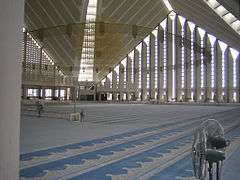
Interior of the mosque.
See also
References
- 1 2 3 4 "Faisal Mosque". Archnet Digital Library. Retrieved 2011-02-09.
- ↑ "Three Pakistani mosques make it to 'world's most beautiful mosques' list - The Express Tribune". The Express Tribune. 2015-08-03. Retrieved 2016-11-17.
- ↑ "King of All Mosques - Faisal Mosque". HOPES. 2015-11-06. Retrieved 2016-11-17.
- ↑ "Faisal Mosque attracts visitors from all over country". www.thenews.com.pk. Retrieved 2016-11-17.
- ↑ Mass, Leslie Noyes (2011). Back to Pakistan: A Fifty-Year Journey. Rowman & Littlefield. p. 157. ISBN 978-1-4422-1319-7.
- ↑ "Faisal Mosque - Islamabad, Pakistan". www.sacred-destinations.com. Retrieved 2016-11-17.
- ↑ "Faisal Mosque". Atlas Obscura. Retrieved 2016-11-17.
- ↑ Planet, Lonely. "Shah Faisal Mosque in Islamabad & Rawalpindi". Lonely Planet. Retrieved 2016-11-17.
- ↑ Rengel, Marian (2004). Pakistan: A Primary Source Cultural Guide. Rosen. p. 71. ISBN 978-0-8239-4001-1.
- ↑ "Details – Masjid Shah Faisal". Retrieved 2012-06-19.
External links
| Wikimedia Commons has media related to Shah Faisal Mosque. |


